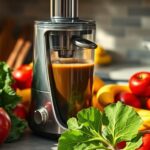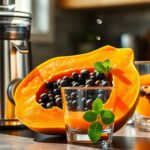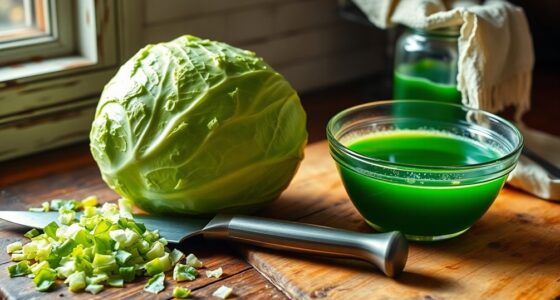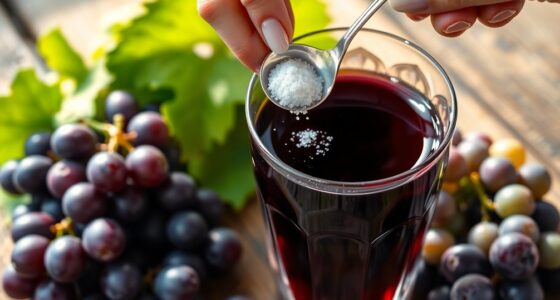If you’re a beginner juicer, be careful with ingredient prep—it can hurt your juice and your health. Not washing or peeling fruits and veggies can lead to bitter flavors and contaminants. Skipping the removal of seeds and pits may introduce toxic compounds. Fresh, high-quality ingredients enhance taste and nutrition, so always choose ripe, organic produce when possible. Want to guarantee your juicing is safe and delicious? There’s more to discover about ingredient prep and safety.
Key Takeaways
- Not washing produce properly can expose you to pesticides, dirt, and harmful bacteria, risking your health.
- Failing to remove seeds and hard pits from stone fruits can lead to bitter flavors and potential toxicity.
- Ignoring the need to peel tough-skinned fruits like citrus may result in a bitter taste and unpleasant texture.
- Chopping fruits and vegetables into smaller pieces enhances juicing efficiency and maximizes nutrient extraction.
- Using non-organic produce can increase chemical residue exposure, diminishing juice quality and safety.
The Importance of Proper Ingredient Preparation
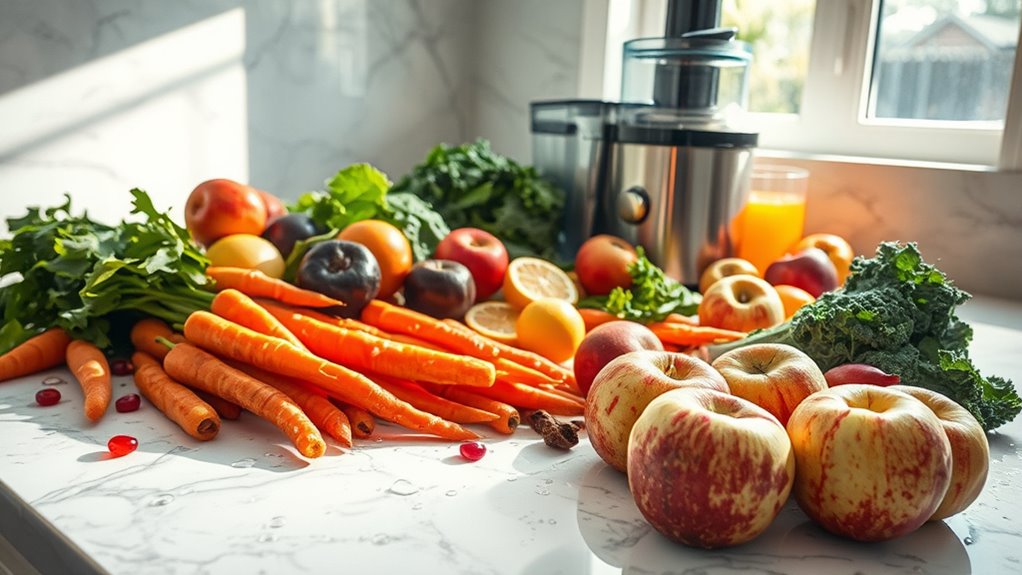
When you jump into juicing, don’t overlook the importance of proper ingredient preparation. Washing, peeling, and chopping fruits and vegetables sets the stage for a smooth juicing process.
By taking the time to chop produce into smaller pieces, you fit them into the juicer chute easily and guarantee efficient extraction. Don’t forget to remove seeds and hard pits from stone fruits; they can ruin the taste and even contain toxic compounds.
Preparing your ingredients ahead of time not only speeds up the process but also enhances the taste and maximizes nutritional benefits. Fresh, properly prepared ingredients make all the difference, allowing you to enjoy delicious, nutrient-packed juice without any bitter flavors from peels or tough skins. Additionally, the freshness of your juice is crucial, as freshly squeezed juice can last only 2-3 days in the fridge and fresh orange juice retains more nutrients than processed juice.
Common Produce Prep Mistakes
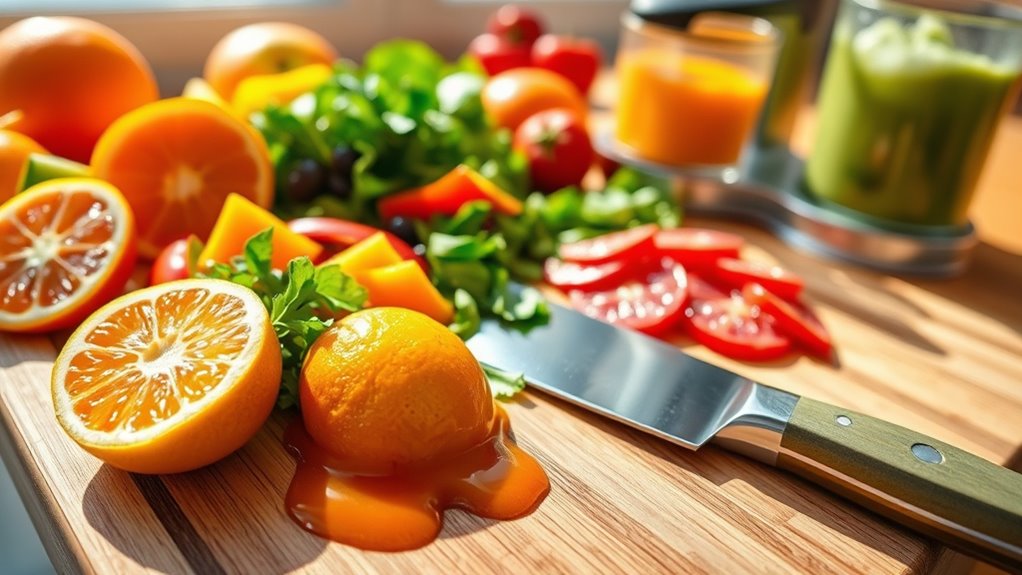
Failing to properly prepare your produce can lead to disappointing juicing experiences. One of the most common juicing mistakes isn’t chopping your fruits and veggies into smaller pieces. This step guarantees efficient extraction and minimizes waste.
Don’t forget to peel citrus fruits, as the white pith can introduce bitter flavors to your juice. Additionally, always remove seeds and hard pits from stone fruits; they can contain toxic compounds that affect both flavor and safety.
To make cleanup easier, consider lining your pulp collection bin with plastic wrap. Properly prepping your produce not only saves time but also maximizes nutrient retention, making your juicing experience more enjoyable and beneficial. Furthermore, ensure that your ingredients are fresh and free from pests such as aphids to maintain their health and flavor.
How Ingredient Quality Affects Juice Flavor
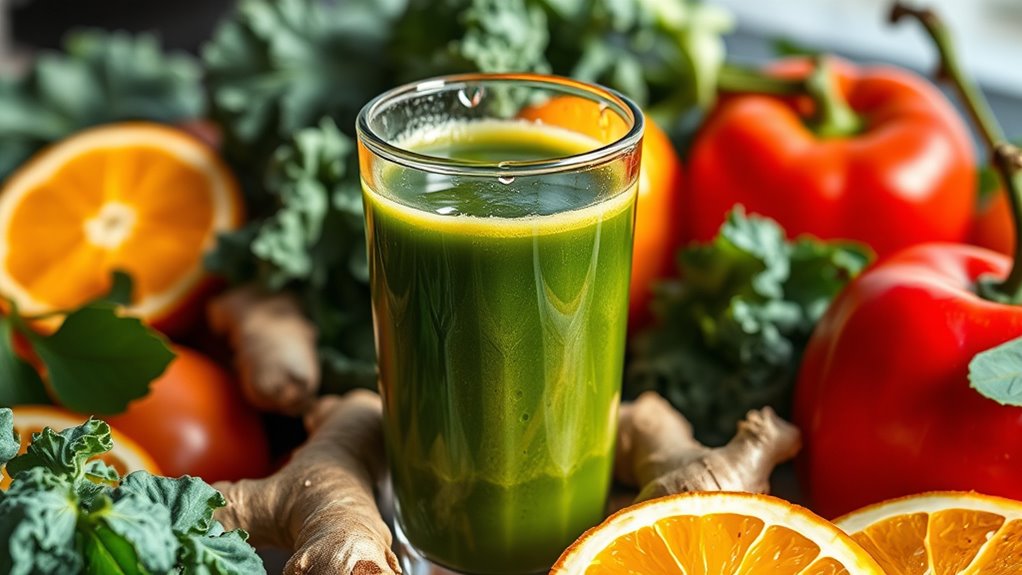
The freshness of your ingredients plays an essential role in how your juice tastes.
When you choose organic produce, you’re not just avoiding pesticides; you’re also enhancing the flavor profile of your drink.
Selecting ripe, seasonal fruits and vegetables guarantees that every sip is packed with vibrant taste and nutrients. Additionally, using fresh ingredients can significantly enhance the flavor and nutrition of your juice.
Freshness Matters
Fresh ingredients are the backbone of delicious juice, directly influencing its flavor and nutritional value. To guarantee you’re enjoying the best juice possible, keep these freshness tips in mind:
- Choose high-quality produce: Always opt for seasonal and ripe fruits and vegetables to enhance flavor and nutrient content.
- Consume quickly: Fresh juice should be enjoyed immediately after preparation, as exposure to air can degrade its nutritional value within minutes.
- Store properly: If you need to store your juice, use an airtight container and drink it within 24-36 hours to maintain quality. Additionally, using freshly squeezed juice can maximize vitamin C intake and ensure you’re reaping the full health benefits of your ingredients.
Organic vs. Conventional
When you choose between organic and conventional ingredients for your juice, the quality of your produce can greatly impact flavor and nutrition.
Organic ingredients, grown without synthetic pesticides and fertilizers, often enhance the natural taste of your juice while minimizing harmful chemical residues. In contrast, conventional produce may contain these residues, which can detract from both flavor and health benefits.
Studies show that organic fruits and vegetables typically offer higher nutritional quality and levels of antioxidants, making your juice more nutrient-dense. Additionally, juices made from beet juice can significantly improve blood flow, enhancing the overall health benefits of your drink.
By opting for organic, you not only enjoy a tastier juice but also contribute to better soil health and an eco-friendly environment.
Ultimately, choosing organic can elevate your juicing experience and support your overall well-being.
Tips for Safe and Delicious Juicing
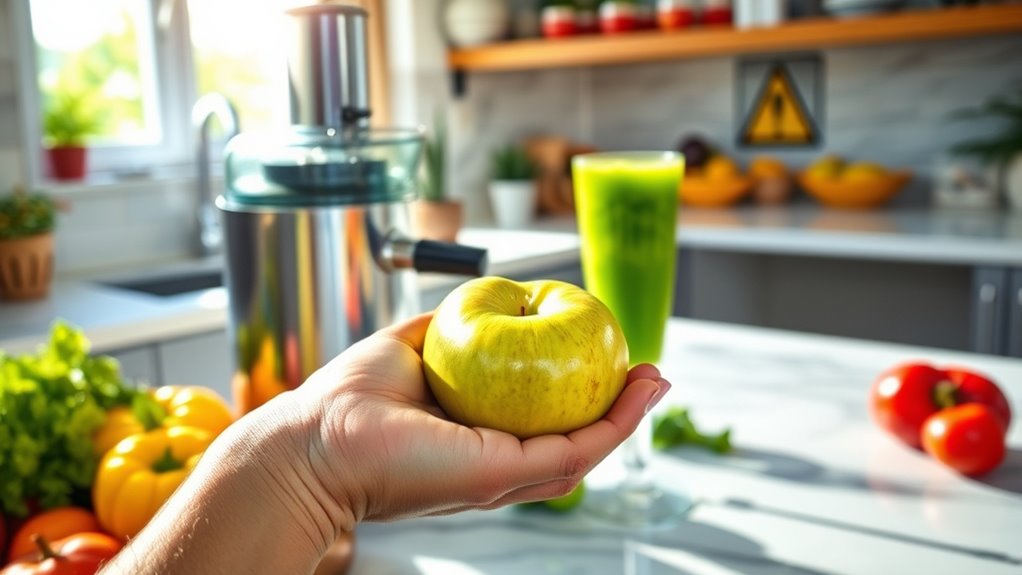
To enjoy the full benefits of juicing, you need to follow some key tips that guarantee your drinks are both safe and delicious.
Here are three essential guidelines:
- Use fresh produce: Always consume your juice immediately after preparation to maximize nutrient retention and prevent degradation of vitamins and antioxidants.
- Balance your ingredients: Aim for a ratio of 75% vegetables to 25% fruits. This helps limit sugar intake while providing a stable energy boost for your daily dose.
- Clean your equipment: Clean your juicer right after use to avoid residue buildup, making the process easier and keeping your juicer efficient.
Additionally, consider incorporating raw foods into your diet, as they may have higher enzyme content beneficial for digestion.
Enhancing Nutritional Value Through Preparation
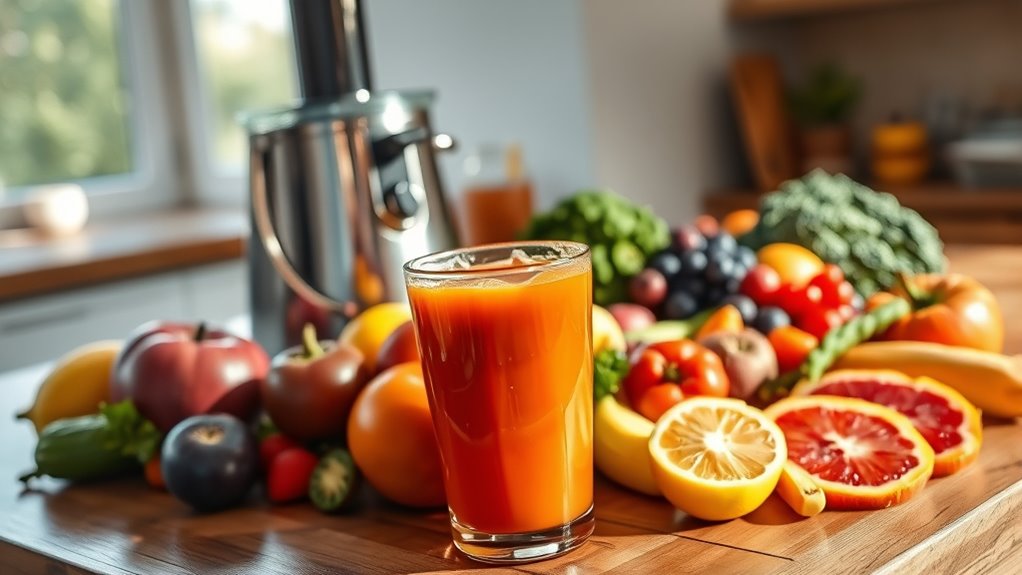
Making delicious and nutritious juice goes beyond just selecting the right ingredients; how you prepare them plays a vital role too. Proper preparation of your fruits and vegetables can greatly enhance nutritional value.
For instance, chopping and peeling can prevent bitterness, especially with citrus fruits, while removing seeds and hard pits is essential to avoid toxic chemicals. If your juice has too much fiber, consider using a cold-press machine, as it maximizes nutrient extraction effectively.
Plus, lining the pulp basket with plastic wrap simplifies cleanup. Avoiding common mistakes in preparation not only streamlines the juicing process but also guarantees you’re getting the most out of every ingredient, steering clear of issues like high pressure pasteurization that can diminish your juice’s benefits. Additionally, incorporating omega-3 rich seeds into your juice can further boost its nutritional profile.
Avoiding Health Risks From Improperly Prepared Ingredients
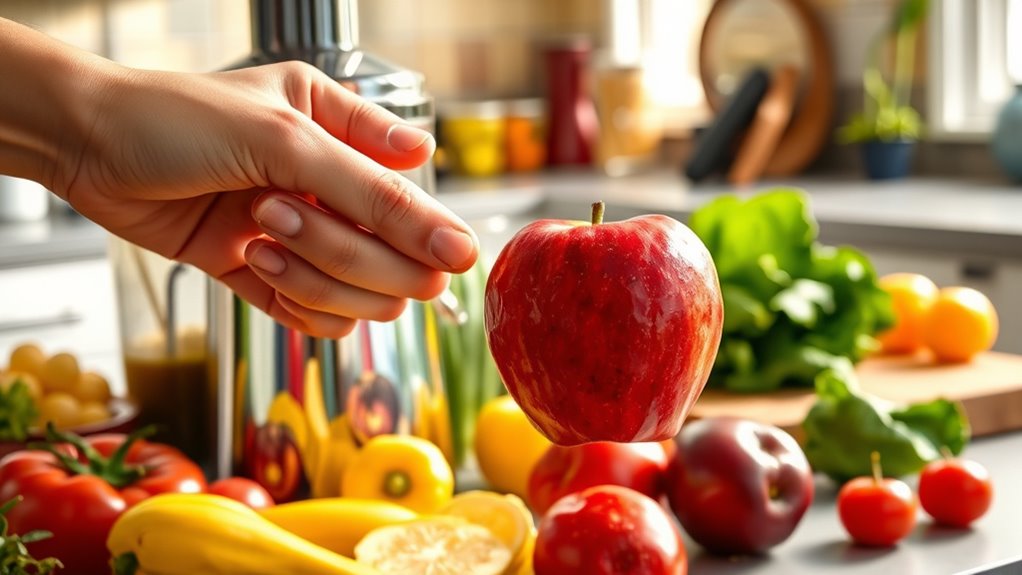
Improperly prepared ingredients can lead to health risks that you mightn’t even consider while juicing. To keep your juice safe and enjoyable, remember these essential tips:
- Peel tough-skinned fruits like citrus to avoid bitter flavors and enhance smoothness.
- Remove seeds and hard pits from stone fruits; they can contain toxic compounds that pose serious health risks.
- Wash all produce thoroughly to eliminate pesticides, dirt, and bacteria. Using organic produce can further reduce pesticide exposure.
Be cautious with leafy greens, too; some, like kale, should be juiced in moderation to prevent digestive issues. Additionally, be aware that improperly stored juice can lead to spoilage and bad lemon juice that may not be safe for consumption.
Frequently Asked Questions
Are There Dangers to Juicing?
Yes, there are dangers to juicing. If you juice too many sweet fruits, you might spike your sugar intake and experience energy crashes.
Overloading on dark greens can lead to nausea, and relying solely on juice can cause fiber deficiency, harming your digestion.
Not varying your ingredients could result in nutrient deficiencies.
Finally, delaying juice consumption after making it can reduce its nutritional quality due to exposure to air, degrading essential vitamins.
What Happens When You First Start Juicing?
When you first start juicing, it’s like opening a vibrant treasure chest of flavors and nutrients. You might feel energized and excited, but you could also face challenges.
If you stick to the same ingredients, you risk nutrient deficiencies. Overloading on fruits can spike your sugar intake, and you mightn’t consume enough calories, leaving you fatigued.
Balancing your juice with various vegetables and following structured recipes will help you reap the benefits without the downsides.
What Is the 80 20 Rule in Juicing?
The 80/20 rule in juicing suggests you should aim for 80% vegetables and 20% fruits in your juice.
This balance helps keep sugar levels in check while ensuring you get essential nutrients. By focusing on vegetables, you boost your fiber intake and add vitamins and minerals that are vital for your health.
Plus, this ratio encourages you to get creative with flavors, making your juicing experience enjoyable and nutritious!
What Should You Not Do While Juicing?
While juicing, don’t stick to the same ingredients every day; it can lead to nutrient deficiencies.
Avoid throwing random items into your juice; stick to structured recipes for better nutrition.
Don’t solely rely on fruits; more vegetables help balance sugars.
Be mindful of your calorie intake; too few calories can leave you drained.
Ultimately, don’t juice for quick weight loss; focus on overall health for lasting benefits.
Conclusion
To sum up, taking the time to properly prepare your ingredients can transform your juicing experience. Did you know that nearly 30% of nutrients can be lost if you don’t wash or chop your produce correctly? By avoiding common prep mistakes, you not only enhance the flavor of your juice but also boost its nutritional value. So, wash, chop, and enjoy your juice knowing you’re getting the most out of every drop! Cheers to your health!
Cindy thoroughly researches juicing trends, techniques, and recipes to provide readers with practical advice and inspiration. Her writing style is accessible, engaging, and designed to make complex concepts easy to understand. Cindy’s dedication to promoting the advantages of juicing shines through her work, empowering readers to make positive changes in their lives through the simple act of juicing.






